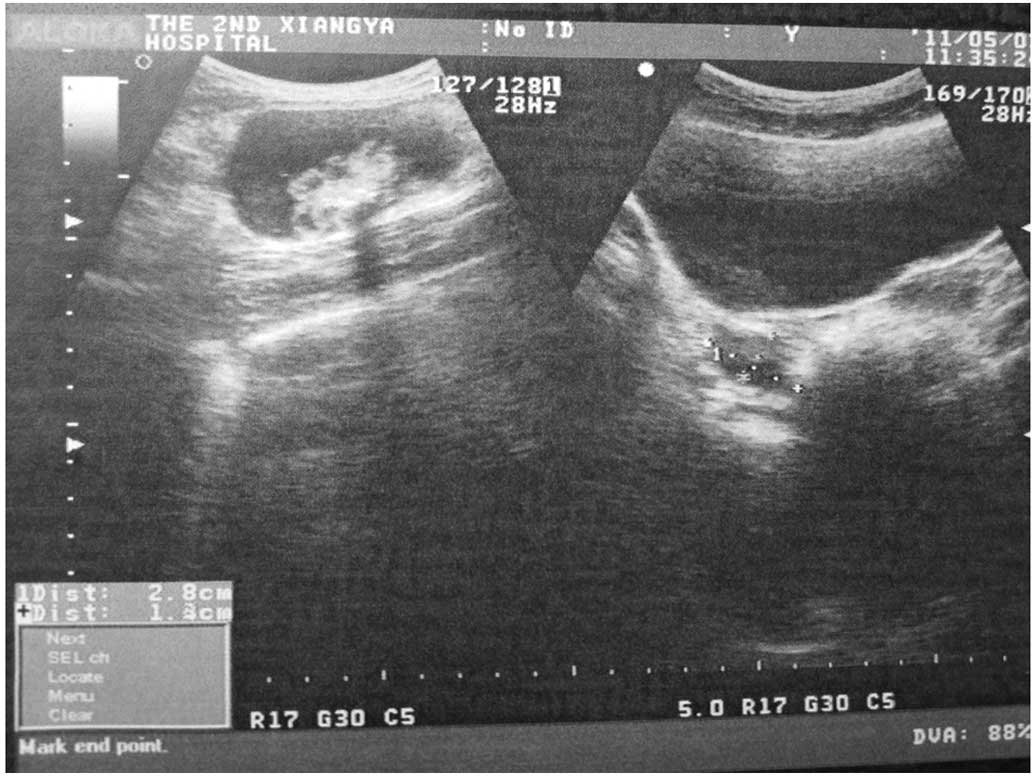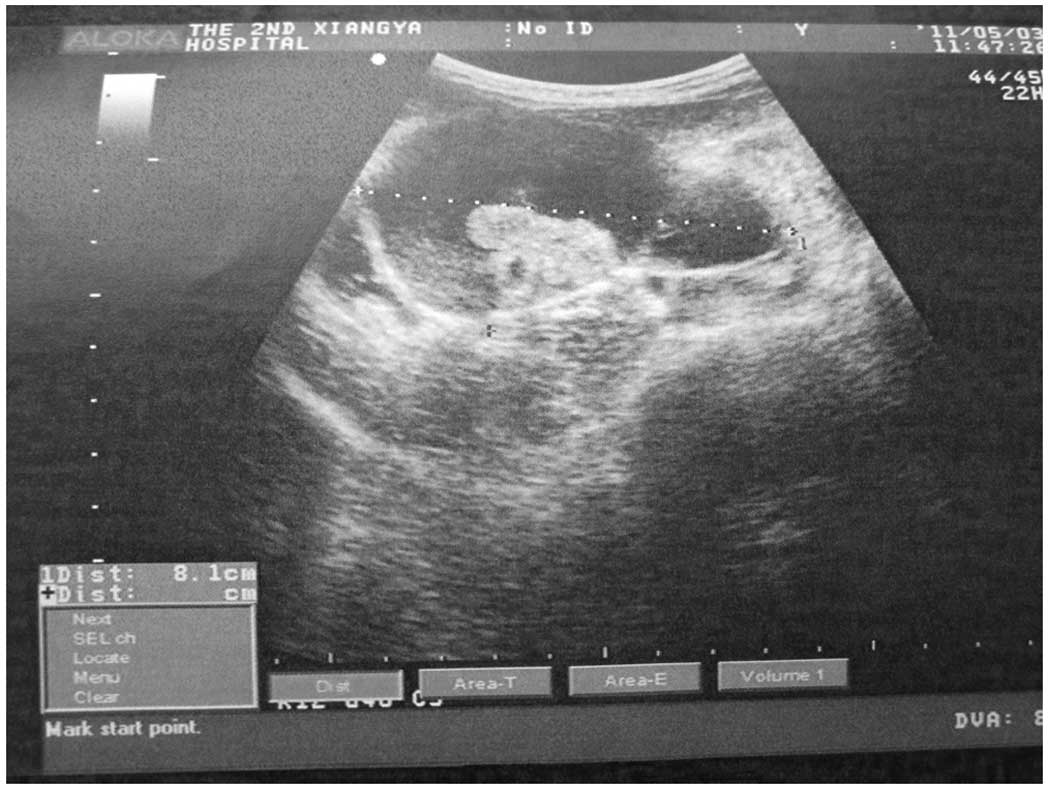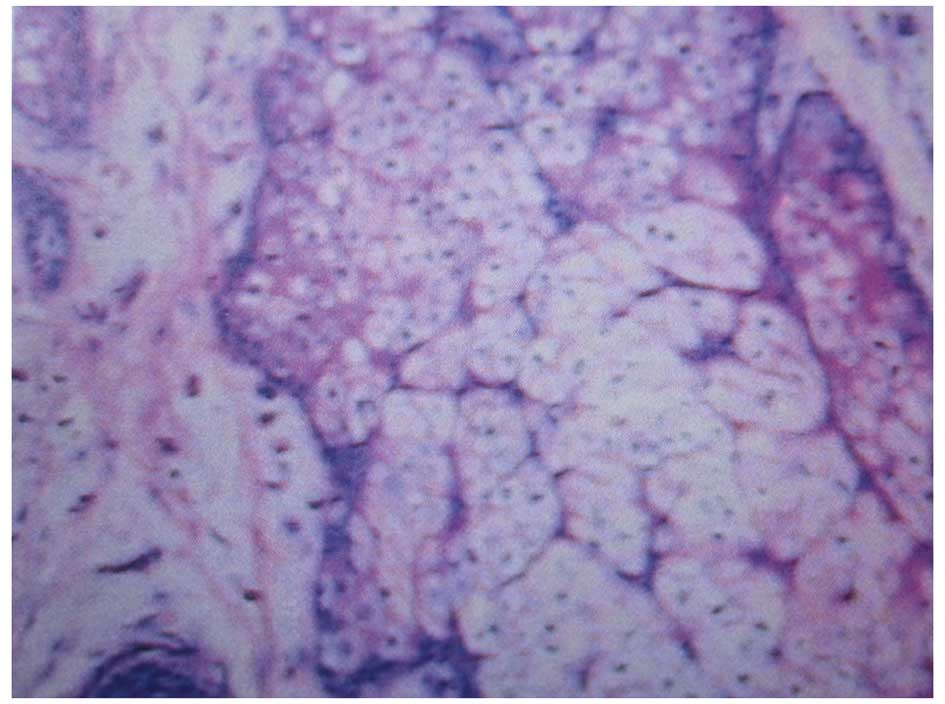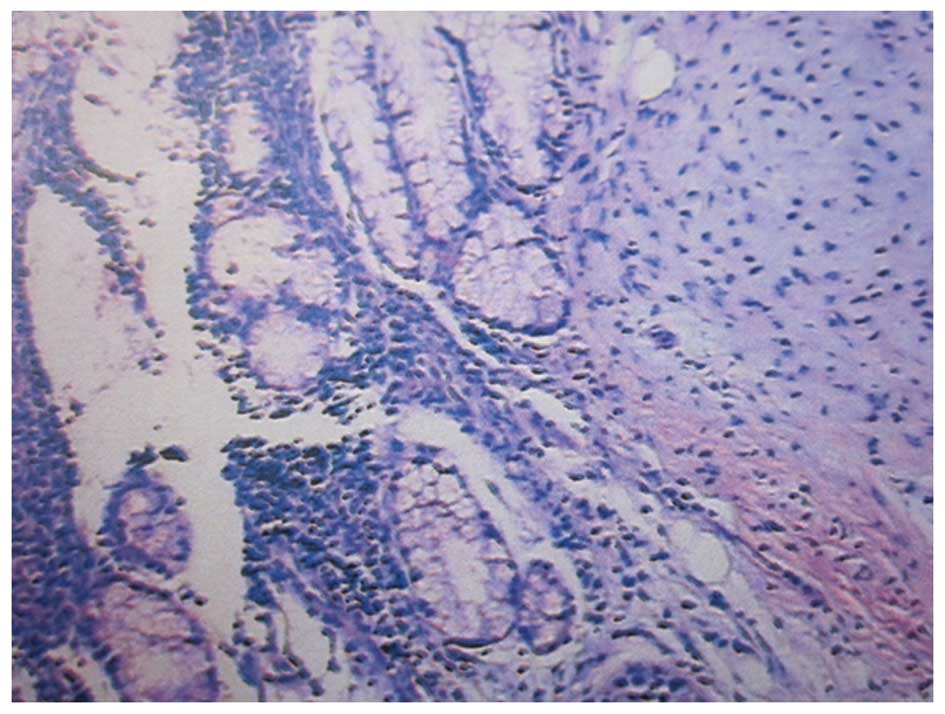Mature cystic teratoma of the fallopian tube associated with incomplete uterine mediastinum: A case report and literature review
- Authors:
- Published online on: May 20, 2013 https://doi.org/10.3892/ol.2013.1355
- Pages: 153-155
Abstract
Introduction
Neoplasms of the fallopian tube are the least common tumors of the female reproductive system. To date, mature teratoma of the fallopian tube associated with incomplete uterine mediastinum has not been reported and ∼60 cases of mature teratoma of the fallopian tube have been reported worldwide. None of the reported cases were diagnosed preoperatively. The pathogenesis of teratoma of the fallopian tube remains poorly understood. Tumors are accidentally discovered and confirmed by pelvic surgery, as a result of diagnosis of uterine fibroids, ovarian cysts and cesarean sections. It has been hypothesized that teratomas originate from the germ cells, as teratomas are found most frequently in the gonads. The karyotype of all benign teratomas is 46,XX. Surgery is used to treat teratomas and the prognosis of this disease is generally good (1–5). In the present case report, the patient was presented to The Second Xiangya Hospital of Central South University (Changsha, China) with fertility issues. The postoperative diagnosis was incomplete uterine mediastinum and mature cystic teratoma of the fallopian tube. One year after surgery, the patient became pregnant and gave birth to a healthy baby. Written informed consent was obtained from the patient.
Case report
Patient presentation
A 23-year-old female (gravida 0, para 0) who had been married for two years was admitted to The Second Xiangya Hospital of Central South University (Changsha, China) with fertility issues. The patient reported intermittent lower abdominal pain for 8 months. The individual’s menstrual cycle was regular. Pelvic examination revealed a stationary cystic mass of ∼8×3 cm in the left adnexal region; the right adnexa and the uterus were normal. The patient’s family history was negative for any hereditary diseases. Serum concentrations of C12 were within the normal limits. Ultrasound examination revealed that the endometrium was unclear, and a cystic mass of ∼8×4 cm to the right of hypogastic region was observed. The mass contained foci of calcification of ∼3×2 cm (Figs. 1 and 2). A pelvic computed tomography (CT) scan revealed a 6×4.5 cm cystic mass in the left pelvis, which was suspected to represent a cystic teratoma of the left ovary (Fig. 3). The density of the uterine body was irregular as shown by enhanced B sonography, which did not eliminate the presence of uterine disease.
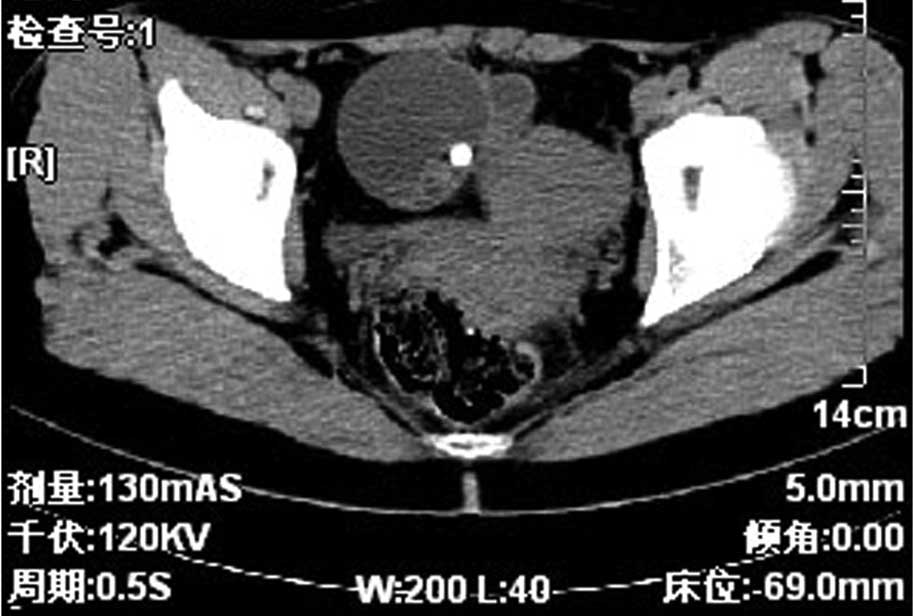 | Figure 3.Pelvic computed tomography (CT) scan revealed a 6×4.5 cm cystic mass to the left of pelvis. |
Surgical procedures
The patient underwent surgery with a diagnosis of cystic teratoma of the left ovary, incomplete uterine mediastinum and infertility. At the time of surgery, incomplete mediastinum (∼2 mm) was observed at the bottom of the uterus. The left fallopian tube appeared to be distended by ∼8×3 cm, and contained cream-colored sebaceous material and hair. The left ovary and the right adnexa were normal. The patient subsequently underwent left salpingectomy and uterine septum incision. The post-operative recovesry was uneventful. The ampullary portion of the left fallopian tube was histologically diagnosed as mature cystic teratoma (Figs. 4 and 5).
Discussion
Tubal teratoma may be associated with other neoplasms (6,7), struma ovarii, ectopic pregnancy (8,9), uterine leiomyomatosis (10) and endometrial adenocarcinoma (11) (Table I). The present case study is the first in the literature to report a mature cystic teratoma of the fallopian tube associated with incomplete uterine mediastinum (11). In addition, the teratoma in the present case was the largest of all reported cases of mature cystic teratomas of the fallopian tube. The diversity of teratoma behavior is likely to reflect the varied biological potential of different stem cells, including germ and pluripotent embryonic cells. Benign teratoma of the fallopian tube is composed of tissues of ectodermal, mesodermal and endodermal origin in any combination (1). Teratomas are initially of mesodermal origin with abundant mesenchymal stroma; however, it eventually develops endodermal and ectodermal derivatives with airway-lining enterocytes, thyroid, brain and skin appendages (12). The majority of cases of benign teratoma of the fallopian tube occur in patients in their 40s and are cystic and exhibit significant variations in size. The majority of benign teratomas of the fallopian tube are unilateral and are common in 1/3 of the fallopian tube or the outer edge of the fallopian tube. The tumors tend to be small and contain sebum-like material with hairs. Fallopian tube teratomas have been associated with reduced parity, menstrual irregularity, leukorrhea, post-menopausal bleeding and abdominal pain. Procedures, including analysis of serum C12 levels, pelvic CT scan, ultrasound examination (13) and hysterosalpingography (12), are useful for diagnosis. The prognosis of the disease is good. In the present case, the patient was 23 years-old; however, the teratoma was larger compared with other studies (14–19). The majority of tubal teratomas are benign. In the current case, the patient suffered from incomplete uterine mediastinum, which was due to paramesonephric duct convergence insufficiency. Intermittent lower abdominal pain has been reported in other cases, consistent with the current case; however, the patient was originally admitted to hospital due to infertility. One year following the surgery, the individual became pregnant.
In conclusion, benign teratomas commonly occur in the ovaries, but are rarely found in the fallopian tubes. Although the present case was a cystic teratoma, immature tissues were not identified by microscopic examination of the specimens by several pathologists. Therefore, a diagnosis of a benign mature cystic teratoma originating in the fallopian tube was reported for this patient.
References
|
Mutter GL: Teratoma genetics and stem cells: a review. Obstet Gynecol Surv. 42:661–670. 1987. View Article : Google Scholar : PubMed/NCBI | |
|
Norris HJ, Zir HJ and Barson WL: Immature (malignant) teratoma of the ovary: a clinical and pathologic study of 58 cases. Cancer. 37:2359–2372. 1976. View Article : Google Scholar : PubMed/NCBI | |
|
Corfman PA and Richart RM: Chromosome number and morphology of benign cystic teratoma. N Engl J Med. 271:1241–1244. 1964. View Article : Google Scholar : PubMed/NCBI | |
|
Rashad MN, Fathalla RM and Kerr MG: Sex chromatin and chromosome analysis in ovarian teratomas. Am J Obstet Gynecol. 96:461–465. 1966.PubMed/NCBI | |
|
Linder D, McCaw BK and Hecht F: Pathogenic origin of benign ovarian teratoma. N Engl J Med. 292:63–66. 1975. View Article : Google Scholar | |
|
Hoda SA and Huvos AG: Struma salpingis associated with struma ovarii. Am J Surg Pathol. 17:1187–1189. 1993. View Article : Google Scholar : PubMed/NCBI | |
|
Mazzarella P, Okagaki T and Richart RM: Teratoma of the uterine tube. Obstet Gynecol. 39:381–388. 1972.PubMed/NCBI | |
|
Pai MR, Naik R and Baliga P: Mature cystic teratoma of the fallopian tube associated with ectopic pregnancy. J Indian Med Assoc. 95:881997.PubMed/NCBI | |
|
Kutteh WH and Albert T: Mature cystic teratoma of the fallopian tube associated with an ectopic pregnancy. Obstet Gynecol. 78:984–986. 1991.PubMed/NCBI | |
|
Chao TJ, Chao J, Kuan LJ, Li YT, Kuo TC, Chang YC and Nieh S: Mature solid teratoma of the fallopian tube associated with uterine leiomyomas. J Chin Med Assoc. 71:425–427. 2008. View Article : Google Scholar : PubMed/NCBI | |
|
Roncati L, Barbolini G, Ghirardini G and Rivasi F: Mature solid teratoma of the fallopian tube mimicking metastasis of endometrial adenocarcinoma: a case report. Int J Surg Pathol. 18:561–563. 2010.PubMed/NCBI | |
|
Fujiwara S, Yamashita Y, Yoshida Y, Terai Y, Okuda K and Ohmichi M: Mature cystic teratoma of the fallopian tube. Fertil Steril. 94:2708–2709. 2010. View Article : Google Scholar : PubMed/NCBI | |
|
Johnson C and Hansen KA: Mature cystic teratoma of the fallopian tube. Fertil Steril. 86:995–996. 2006. View Article : Google Scholar : PubMed/NCBI | |
|
Yoshioka T and Tanaka T: Mature solid teratoma of the fallopian tube: case report. Eur J Obstet Gynecol Reprod Biol. 89:205–206. 2000. View Article : Google Scholar : PubMed/NCBI | |
|
Baginski L, Tazigi R and Sandstad J: Immature (malignant) teratoma of the fallopian tube. Am J Obstet Gynecol. 160:671–672. 1989. View Article : Google Scholar : PubMed/NCBI | |
|
Roberts D: A case of ectopic gestation removal, by abdominal section with a dermoid tumor of the extremity of the left tube. Lancet. 2:1164–1165. 1903. | |
|
Neumann HO: Teratoma der tube. Arch Gynaekol. 130:766–774. 1927.(In German). | |
|
Zelinger BB, Grinvalsky HT and Fields C: Simultaneous dermoid cyst of the tube and ectopic pregnancy. Obstet Gynecol. 15:340–343. 1960.PubMed/NCBI | |
|
Massouda D, Wortham GF III and Oakley JL: Tubal pregnancy associated with a benign cystic teratoma of the fallopian tube. A case report. J Reprod Med. 33:563–564. 1988.PubMed/NCBI |



